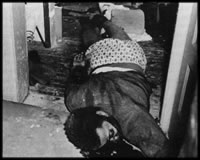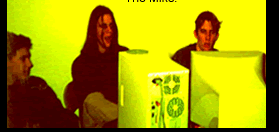
The Infamous COINTELPRO of the FBI and their complete disruption of the Black Panther Party.
by Mike Elfers
‘I’m punch-drunk on the sickening cadence of iron-fists in velvet gloves. The Cheshire grins. The crippling Judas kiss to christen thee a sinking ship and …the purpose of this new counter-intelligence endeavor is to expose, disrupt, misdirect, discredit or otherwise neutralize… any parades that you can’t jump in front of. Any long years of hard work that ain’t yours. Sometimes I wonder if you just can’t help yourself? Overhead bloodthirsty vultures circle patiently. They offer condolences (and whisper bitter eulogies). Yes, “comrades” come as thick as thieves. But you got another thing coming. “With Friends Like These” - Propagandhi’
COINTELPRO’s intense program repressing the Black Panther Party in the 1960’s strongly replaces the normal image of smiling, moral police officers or FBI officials alive to help people, to an image of “bloodthirsty vultures, circling patiently” knocking out any source of the threat they have named this political dissent to be. The facts around the entire operation will live forever in regret, from its conduction to its cover-up, and will forever be blamed on the times when they occurred… the cold war.
COINTELPRO is an acronym for the FBI’s domestic “counterintelligence programs” to neutralize political dissidents. Although covert operations have been employed throughout FBI history, the formal COINTELPRO’s conducted between 1956-1971 were broadly targeted against radical political organizations.
The origins of COINTELPRO were rooted in the Bureau’s operations against hostile foreign intelligence services. Counterintelligence, of course, goes beyond investigation; it refers to actions taken to neutralize enemy agents.
“Counterintelligence” was a misnomer for the FBI programs, since the targets were American political dissidents, not foreign spies. In the atmosphere of the Cold War, the American Communist Party was viewed as a serious threat to our national security. (Wolf 2)
COINTELPRO was, in a literal sense, an excuse for the American Government to get away with conducting investigative operations within the United States. At the suspenseful times of the cold war, everyone feared all possible threats to America’s national security, everyone, including the Federal Bureau of Investigation.
J. Edgar Hoover, director of the FBI, was a strong token in the entire existence of COINTELPRO. Under his direction, the following account is just one of several complete disruptions of political dissidents.
’In 1967, FBI Director J. Edgar Hoover wrote that the purpose of COINTELPRO was to “disrupt, misdirect, isolate and neutralize” political dissidents’ (Bleifuss and Helvarg 1994).
His honest proposal of the reasoning behind COINTELPRO was the safety of the people, protection of American citizens through this deep investigational system from within our country.
Arguably, COINTELPRO-BPP was J. Edgar Hoover’s personal monument, the capstone of ugliness to a career characterized by the craft and construction of an empire devoted to violent repression in the name of all that is good and sacred. Moreover, his passing, and the spate of Watergate era investigations of Bureau activities, with all the supposed “reforms” these entailed, did little or nothing to alter the fundamental nature of what Hoover had wrought. Lead cannot, after all, be transformed into gold by the waving of the alchemist’s wand. The full horror and implications of COINTELPRO-BPP were discretely and, all too often, conveniently overlooked; Hoover’s “outfit” was left intact, ritually chastised perhaps, but unpunished for its “excesses,” its priorities and ideology unscathed. (Churchill and Vander Wall 99)
COINTELPRO-BPP, the FBI’s code name for the Black Panther operation, as well as many other COINTELPRO related incidents, remained overlooked for some time being the reasoning behind the programs, or the incredible sources of evidence the Bureau found that would have eventually lead to an actually legal or judicial disruption of each of the political dissidents.
The Bureau grew deeply attracted to the Black Panther Party after the murder trials of panther leaders Bobby Seale and Ericka Huggins (Churchill and Vander Wall 52).
Seale and Huggins were thrown into a large, media filled, court case involving murder by the FBI as one of the first attacks towards the political party by COINTELPRO.
Although such political trials were never formally a part of COINTELPRO, their relationship to it is brought out quite clearly by the Seale-Huggins case. In this matter, the murder victim was a young Panther candidate from New York named Alex Rackley who had been bad-jacketed as a police infiltrator. The perpetrator of the bad-jacketing, as well as Rackley’s interrogator-the youngster had been shackled to a bed and scalded for days prior to being shot to death-and executioner was an ostensible Panther captain named George Sams. Sams, as it turned out, had been a paid FBI informer for a period of time never disclosed by the Bureau; Seale and Huggins seem to have been drawn into the matter almost as a “dividend” or afterthought. (Churchill and Vander Wall 53)
Bobby Seale and Ericka Huggins were both chairmen for the Panthers in the Chicago area, and were tried for involvement of the murder of Rackley. Bobby Seale was notably accused because of his history in the foundation of the Black Panther Party.
Founded in 1966, the Black Panther Party started a fight for freedom for the Black communities in America. Strong believers in racial equality, Huey Newton and Bobby Seale, founded the party. After the newly assembled group disrupted gun-control hearings in Sacramento in 1967, the group had a famous shoot-out with Oakland police in result of founder Newton’s arrest. Soon after the Panthers announced an official alliance with the Student
Nonviolent Coordinating Committee, immediately after this, the FBI began full investigation of the Panther Party through COINTELPRO (Haskins 122).
The Black Panther Party fought for the same thing that many other political parties fight for: their civil rights. In the 1960’s and 70’s, black civil rights were not equal to whites, and the Panthers fought hard to try to earn such equality. The Party supported Martin Luther Kings Jr.’s movement, they also supported his theory on nonviolence, but it was King’s denial to confrontation that they opposed. They believed that confrontation of the superior white Government that their rights were unequal would lead to improvement of their civil rights. The Federal Bureau of Investigation believed that this confrontation held a threat to the United States, and must be annihilated. By April of 1968, less than two years after the party’s foundation, the FBI declared the Panthers a serious threat to United States security (Haskins 122).
Noam Chomsky, a renowned professor of linguistics at MIT, political dissident, and author of over 30 political books, once called Fred Hampton, a Panther from Chicago, “one of the most promising leaders of the Black Panther Party” (Churchill and Vander Wall 64).
Which, in reality, he was. During the murder trials of Bobby Seale and Erika Huggins, his responsibility in speaking as the Chicago Panther leader shined incredibly. One of his most famous moments was addressing a “Free Bobby Seale” rally in October of 1969. Much earlier, however, the Bureau had already informed the Racial Matters Squad of his possible threat to the future of the nation.
Already in late 1967, the Bureau’s Chicago SAC, Marlin Johnson, had instructed his Racial Matters Squad to open a file on the nineteen-year-old, a manila folder which was expanded to twelve volumes containing more than 4,000 pages over the remaining two years of Hampton’s life. At the same time, an informant was planned in the Maywood NAACP office. At least as early as February 1968, Johnson also requested the installation of a wiretap on the phone of Hampton’s mother, Iberia. By May, Johnson had placed the young Panther’s name on the “Agitator Index” and saw to it that he was designated as a “key militant leader” for Bureau reporting proposes. (Churchill and Vander Wall 64)
In 1968, a young man named William O’Neal was brought into the Racial Matters Squad for recent arrests for interstate car theft, and impersonating a federal officer. In exchange for a clean record, O’Neal agreed to infiltrate the Chicago Panther Party for the FBI. By early 1969, O’Neal had moved up to the position of the “number three man” in the Chicago Party and was in line for the national Panther Party. O’Neal was awarded the job as Hampton’s bodyguard, for the FBI was planning to raid an apartment complex that Hampton and a few other Panthers lived in. O’Neal created floor plans of Hampton’s apartment to aid the future raids, and was also suspected of drugging Hampton before the raid, leaving him defenseless. (Churchill and Vander Wall 67)
On the morning of December 4, Daniel Groth of the FBI and a unit of fourteen men, heavily armed, raided the apartment housing Hampton, and the other Panthers. When they arrived, using O’Neal’s floor plans, they divided into two teams. At about 4:30 A.M. Gloves Davis of the FBI unit kicked open the front door and shot Panther Mark Clark pointblank in the chest. He had fallen asleep in the couch in the front room with a shotgun in his lap, and his reflexive response of the shot discharged his shotgun. This was the only shot fired from the Panthers. The raiders quickly killed eighteen-year-old Brenda Harris, shooting her with not one
but two rounds. Finally the unit, using O’Neal’s floor plans, began shooting the wall facing Hampton’s bed, having knowledge that he was sleeping in that exact area, fired fourty-two shots into the head of Hampton’s bed, one of the shots, struck a sleeping Hampton on his left shoulder, seriously injuring him. (Churchill and Vander Wall 72)
The unit then finished their planned assassination of Fred Hampton, described in detail by the survivors.
Two shots were then heard, both of which were fired pointblank into Hampton’s head as he lay prone, followed by Carmody’s voice stating, “He’s good and dead now.” The chairman’s body was then dragged by the wrist from the bed to the bedroom doorway, and left lying in a spreading pool of blood. (Churchill and Vander Wall 73)
After dragging the deceased Hampton to the doorway by his wrist, the unit continued firing at
the remaining Panther members. “Doc” Satchel, Blair Anderson, and seventeen-year-old Verlina Brewer were all shot during the barrage. The victims remaining were dragged bodily outside, and were arrested in the street for attempted murder charges and aggravated assault (Churchill and Vander Wall 73).
This raid proves first, the extreme knowledge and possible intelligence of the FBI. They were able to plan the entire raid, before it even happened. The Bureau, thanks to O’Neal’s floor plans, was able to pinpoint exactly where Hampton was sleeping, therefore being able to strike him before he even knew what was going on.
Hampton’s nineteen year old pregnant fiancé, Deborah Johnson, was lying next to Hampton in bed, although she was drenched in blood from his wounds, she survived the raid, without one bullet striking her (Haskins 70).
The raid takes a different path as these factors enter the story. Now there is a fiancé, and a bearer of Hampton’s child, who will have to finish their lives without a father, this adds sympathy to the life of Fred Hampton, no matter what he was suspected of doing.
Hampton’s fiancé was among the survivors of the raid arrested for attempted murder of the raiders and aggravated assault. She was beaten, arrested, fingerprinted, and put in jail while pregnant, and wearing clothes drenched in her future husband’s blood (Churchill and Vander Wall 74).
An immediate cover-up story was written up for excuse of the horrible massacre. Panther Mark Clark, who fired the shotgun in his lap from reflex of being shot in the chest, was said to have fired the first shot. The FBI unit also reported the broad statement that “Hampton’s apartment contained illegal weapons.” The FBI even reenacted the entire raid for a television series to prove their actions were in self-defense. An investigation was performed, and a department ballistics expert, John Sadunas, who was helping with the investigation, said that it had been a “whitewash” and “the worst investigation” that he had ever been a part of. In February 1970, Marlin Johnson testified before the Federal Grand Jury stating that the Bureau’s involvement in the “Hampton-Clark affair” had been, “extremely peripheral.” He neglected to include knowledge of the floor plans, or any other COINTELPRO-related activity. Finally, in 1983, after numerous cases in court related to the raids, presiding judge John F. Grady ruled that there had been a government conspiracy to kill Hampton. The Panther Party received $1.85 million for the survivors and deceased, and sanctions were imposed upon the FBI for the cover-up. (Churchill and Vander Wall 75).
Finally, the truth came out, and everyone’s opinion about the FBI quickly dropped. They had been blamed for a conspiracy, murder, and a cover-up, and the fact that the FBI would hide something from the citizens of the U.S. made the public wonder once again what else was being hidden from them. Money might have been given to the Party and family members, but the innocent lives were already taken (Churchill and Vander Wall 75).
“CO-INTEL-PRO” is FBI lingo for its illegal (and once top-secret) Counterintelligence Program. Cointelpro was part of the FBI’s unjustifiable disruption of legal political activities of American citizens-activities protected by the Bill of Rights. (Chomsky vii)
The FBI, a group that is supposed to protect Americans, has harshly violated rights. The life of Fred Hampton, and the other Panthers ruthlessly murdered in the raids, will never come back, and the fact that they were assassinated by the FBI for their position in the Black Panthers, a political party making use of one of their American rights, is very unjust.
Works Cited
Blackstock, Nelson & Introduction by Chomsky, Noam. COINTELPRO: The FBI’s Secret War on Political Freedom. New York, NY: Vintage Books, 1975.
Bliefuss, Joel and Helvarg, David. “Hostile Environment.” IN THESE TIMES. p.12-19. SIRS. 17 Oct. 1994.
Churchill, Ward and Vander Wall, Jim. Agents of Repression: The FBI’s Secret Wars Against the Black Panther Party and the American Indian Movement. Boston, MA: South End Press, 1990.
Propagandhi. “With Friends Like These.” Today’s Empires, Tomorrow’s Ashes. Fat Wreck Chords, 2001.
Wolf, Paul “Cointelpro.” Church Committee Reports, The. March 2002. [http://www.cointel.org].
Back.
|



